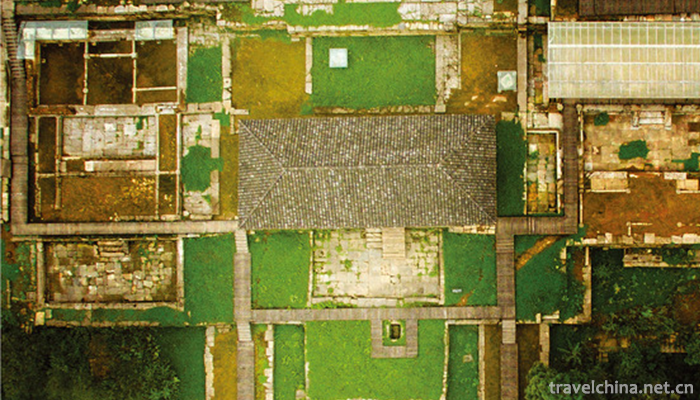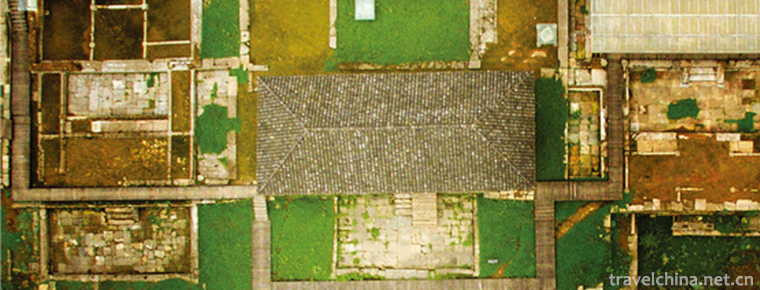Hailongtun Site
Hailongtun Site
Hailongtun is located on the top of Longyan Mountain, about 28 kilometers northwest of Zunyi City, Guizhou Province. It is also called Hailongdun, Longyantun and Longyantun. It is a castle site of Tusi in Song and Ming Dynasties. Its administrative division belongs to the Shuanglong Formation of Hailongtun Village, Gaoping Town, Huichuan District, Zunyi City.
The highest elevation in Tunshang is 1354 meters, and the lowest elevation is 974 meters. The relative elevation difference is about 300-400 meters. Tunding is flat and covers an area of about 1.59 square kilometers. There are nine gates in Tun Shang and six gates in front of Tun Shang: Tong Zhuguan, Tie Zhuguan, Feihuguan, Feilong Guan, Chaotian Guan and Feifengguan, and three gates after Tun Shang: Wan'an Guan, Erdaoguan and Toudaoguan.
Hailongtun was promulgated as a provincial cultural relics protection unit in 1982, promoted to a national key cultural relics protection unit in 2001, and listed in the World Heritage List at the 39th World Heritage Congress on July 4, 2015.
Historical evolution
Traceability
History records show that since the Qin and Han Dynasties, in the southwest of China, including Zunyi (formerly known as Bozhou), the central dynasty has been carrying out the policy of "subjugating foreigners with barbarians", and the territory was handed over to the local officials who paid tribute to the court. In order to maintain its dominant position, Yang Chieftain of Zunyi had three repairs to Hailongtun.
In the thirteenth year of middle school (859), Nanzhao Chief Dragon claimed that the emperor sent troops to occupy Soochow. Annan Capital protects the duplicate broadcasting state.
Tang Yizong Xiantong fourteen years (873 AD), Nanzhao Tusi anti-Tang, seized Soochow.
In the three years of Tang and Qianfu (876 A.D.), Yang Duan, the ancestor of Yang's family in Bozhou, took charge of Bozhou in Taiyuan, Shanxi Province. In order to preserve strength and fight with other tribes, he chose Longya Mountain to send troops.
Evolution
Baoqing three years (1227) in Southern Song Dynasty, Mongolia destroyed Xixia, Duanping first year (1234) combined with Song Dynasty destroyed Jin. After the extinction of gold, Mongolia and the Southern Song Dynasty began to face a positive conflict. The strategy adopted by Mongolia to bypass the Southern Song Dynasty from the west to the East made Sichuan and Chongqing the first place to fight frequently.
In the second year of Chunyou in the Southern Song Dynasty (1242), Yu Yu Yu was appointed as the placator of Sichuan Province, presiding over the defense of Sichuan Province, and publicizing his contributions.
In the fifth year of Baoyou in Southern Song Dynasty (1257), Lu Wende and Yang Wenyi, the envoys of the two governments, built a new city of Longyan because they thought it was the foundation of Bozhou. Longyan is now Hailongtun, so it is generally believed that Hailongtun was built in 1257. (The Stele of Yang Wen's Shinto)
Baoyou in Southern Song Dynasty (1258) first month, the Southern Song Dynasty sent Lufengnian Shu to supervise the Pass and Tungao affairs in Bozhou and other places.
In the first year of Kaiqing in Southern Song Dynasty (1259), Montgomery Khan died in the battle of Diaoyu City, which had a great impact on the later historical trend. All these are closely related to the positive advice and experience of Bozhou people.
In the first year of Wanli in Ming Dynasty (1573 A.D.), Yang Yinglong inherited the mission of propaganda envoy in Bozhou.
After the seventeen years of Wanli (1589 A.D.), Yang Yinglong adopted a two-handed strategy, making friends and attacking close, repairing the upper court and the court without major contradictions and conflicts of interests with the Ming Dynasty, and was often rewarded by the court. The privilege of Tusi was exercised downwards, which intensified the contradictions within Bozhou.
In the 24th year of Wanli in Ming Dynasty (1596 A.D.), Yang Yinglong, the Tusi of Yang's 29th generation, mobilized 80,000 servicemen and craftsmen and spent four years expanding castles and palaces on the basis of Longya Tun built by his ancestors, building 12 gates around them and building huge fortresses on mountains within 5 square kilometers. Buildings are built with jacks of huge stones. The gates are inscribed with the names of the gates. Arrow towers, warehouses, barracks and water jails are built on the gates. The stone walls between the gates are facing each other.
In the twenty-seventh year of Wanli (1599) of the Ming Dynasty, Yang Yinglong was consoled by the propaganda of Bozhou, and the court urgently sent 240,000 troops to eight routes. In the following year, Hailongtun was defeated and Bozhou (now Zunyi, Guizhou, to northern Guizhou) was calmed down. It lasted 114 days and was historically known as the Battle of Pingbo.
In February of the 28th year of Wanli in the Ming Dynasty (1600), Governor Li Hualong led the Eighth Route Army to broadcast it on the air. In mid-April, he joined Hailongtun, where a bloody battle began. On June 6, Hailongtun was attacked and Yang Yinglong hanged himself.
In the 20th year of Wanli (1601 A.D.), the Ming court abolished the Tusi system in Bozhou, appointed by the central government, and exchanged with local officials. It declared the end of the hereditary Tusi system of Yang surname, which ruled Bozhou for 725 years. From then on, the curtain of the "Turkish Return" in the Tusi area of the whole country was opened.
Repair history
In 1999, the Zunyi Municipal People's Government allocated funds to repair the 36-step ladder at Feihuguan.
In April 2002, Guizhou Cultural Relics Conservation Research Center compiled the Design Plan of Hailongtun Conservation and Reinforcement Project in Zunyi, Guizhou.
In September 2004, Shaanxi Institute of Ancient Architecture was entrusted with the preparation of Hailongtun Cultural Relics Protection Plan.
On September 10, 2005, the upper division of Hailong Tun was managed by the Huichuan District People's Government.
From February to September 2007, the people's government of Huichuan District carried out rescue maintenance on the city wall between Tongzhuan Pass and Tiezhuguan Pass in Hailongtun.
In 2008, the collapsed rocks of Xiamatai and Feihuguan in Hailongtun were cleaned up, and waterways, Feihuguan wooden bridge and tourist trails were repaired.
In 2009-2010, the Feihuguan renovation project was implemented, and the Feihuguan was renovated as a whole.
In March 2012, the declaration of the Tusi Site at Hailongtun in Huichuan District for World Cultural Heritage was launched.
From 2014 to 2015, the cultural relics such as Tongzhuguan, Tiezhuguan, Wan'anguan, Xiguan, Houguan, Watchtower, Haichao Temple and Ming Dynasty architectural sites were renovated.
Visiting reference
Climate
Zunyi, where Hailongtun is located, is located in the humid area of the middle subtropical monsoon climate. Like most areas of Guizhou Province, there is no severe cold in winter and no severe heat in summer. The annual average temperature is between 13 and 18 degrees Celsius, with abundant rainfall and sunshine. The warm and humid climate makes Zunyi a tourist attraction, and the tourism suitability of its climate resources is rare in China.
Optimum travel time
Due to the climatic characteristics of Zunyi, Hailongtun can be visited all the year round.
Traffic profile
The fare is 5 yuan for the bus from Maotaopu to Gaoping, and 10 yuan for the special line bus from Gaoping to Hailongtun, which can be reached in about 20 minutes.


-
1.Jiuzhaigou Valley Scenic and Historic Interest Area
Jiuzhaigou: World Natural Heritage, National Key Scenic Spots, National AAAAA Class Tourist Scenic Spots, National Nature Reserves, National Geoparks, World Biosphere Reserve Network, is the first nat
Time 2018-10-13 -
2.Dalian Laohutan Ocean Park
Dalian Laohutan Ocean Park is located in the middle of the southern coast of Dalian, a national scenic spot. It covers an area of 1.18 million square meters
Time 2018-12-02 -
3.mount fanjing
Fanjingshan: National AAAAA-level tourist attractions, National Nature reserves, China's top ten summer resorts, China's famous Maitreya Bodhisattva Dao
Time 2018-12-12 -
4.Qingjiang Gallery Scenic Area
Qingjiang Gallery Scenic Area, National AAAAA Class Tourist Area, National Geopark, National Forest Park, Ten New Brands of National Cultural Tourism, Ten Best Scenic Areas in Hubei Province, and Hube
Time 2018-12-12 -
5.Jiuxiang Scenic Spot
Yiliang Jiuxiang Scenic Spot is located in a mountainous area with a cool climate, continuous peaks and valleys with a relative height difference of about 200 meters. The surface elevation is between
Time 2018-12-22 -
6.Mingshan Scenic Area
Famous Mountain Scenic Area is located on the beautiful bank of Heilongjiang Province, across the river from the Russian Jewish Autonomous Prefecture
Time 2019-02-07 -
7.Cloth tiger
Cloth tiger is a kind of traditional handicraft which has been widely spread among Chinese people in ancient times. It is also a good toy for children, indoor decoration
Time 2019-04-04 -
8.Dong year
In Dong year, Dong language is called Ninggan, also known as Winter Festival or Yang Festival. Winter Festival was originally a festival of Yang surname of Dong nationality.
Time 2019-04-27 -
9.Xibo Folk Songs
Xibo folk song is an important kind of traditional music culture of Xibo nationality, which is widely spread among the Xibo people in Chabchal Xibo Autonomous County and Xinjiang. Folk songs are an im
Time 2019-07-01 -
10.Weaving and Dyeing Techniques of Adlais Silk
Adlais silk is produced in Jiya Township, Luopu County, located in the northwest of Luopu County, on the East Bank of the middle and lower reaches of the Yulong Kashi River. Ancient Hetian was the tra
Time 2019-07-06 -
11.Han Yu
Han Yu (768 - 824 December 25th) retreated. Henan Heyang (now Henan Province Mengzhou People. Claiming to be "Changli," the world is called "Han Changli" and "Mr. Changli"
Time 2019-09-07 -
12.Beijing Information Science And Technology University
Beijing Information Science and Technology University (Beijing Information Science and Technology University), located in Beijing City, is a city with a coordinated development of engineering, managem
Time 2019-09-21